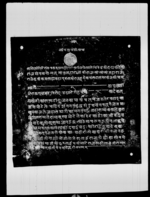A copper plate inscription of an order by King Rājendra to the Bhaṭṭa priests and other officials regulating entry into the Paśupatinātha temple (VS 1885)
ID: PN_0004_0060
Edited and
translated by Axel Michaels
in collaboration with
Manik Bajracharya
Created: 2020-11-25;
Last modified: 2021-02-22
For the metadata of the document, click here
The accompanying edition, translation/synopsis and/or commentary are available under the terms of the Creative Commons Attribution-ShareAlike 4.0 International License
Abstract
This copper plate inscription by King Rājendra is addressed to the Bhaṭṭa priests and other officials and regulates entry into the Paśupatinātha temple premises for Hindu and other castes.Diplomatic edition
[1r]
1श्री\1श्रीपशुपतीनाथ[seal with the legend: श्रीश्रीश्रीराजेन्द्रविक्रमसाहदेव१७३८]1स्वस्तिश्रीगिरिराज:चक्रचूडामणिनर:नारांय़णेत्यादिविविधवी2राजमानमानोन्नत्श्रीमन्महाराजाधीराज:श्रीश्रीश्रीमहाराज :
3राजेन्द्रवीक्रमसाहावाहादूरसम्सेर:जङ्गदेवानांसदासमरवीजयीनाम्
4आगे¯¯¯¯¯¯१¯¯¯¯¯कापूजाहा
5रिराव़ल्भट्टभट्टविसेट्:भडारिगैह्रप्रती¯ ¯१¯कादेवाल्
6यकोढोकासम्म:हीन्डु:जातकापानीचल्नेजातलेरपाहाड्∙का
7तामांभोटेले:चढिदर्शनगर्नुहुंछहीडुपानीनचल्नेजातमा:
8कामकाजलेजाहासम्मगैकामगर्नुपर्छ:ताहासम्म:कसाहिकुस
9लेजात्सम्मलेर:थाक्स्याभोटेलेवाहिरकाढोकाभीत्रदेव़
10ल्वाहेक्चोक्सम्मजानहुंछ:सीढिमाचढनहुदैनअरूपो
11ढेच्यामषलक:कामीसार्की:दमाईभाड्:वाडिरहिन्डुवाहेक्का:
12पानीनचल्नेजातलेचोकका:वाहीरीढोकावाट:भीत्रजानहु
13दैनयोथीतीनाघीजोजालातेस्लाईसजायेहोलासोवमो
14जीम्नगर्यातीमीहरुलाईपनीभारिसजायहोलाइतीसम्वत्
15१८८५साल्मीतीचैत्रवदि६रोज५श्भ्म्¯¯¯¯¯¯¯¯¯¯¯¯¯¯¯
Translation
[1r]
Śrī Paśupatinātha
[seal with the legend: śrīśrīśrī rājendra vikrama sāhadeva 1738]
Hail! [An order] of him who is shining with manifold rows of eulogy [such as] ‘The venerable crest-jewel of the multitude of mountain kings’ and Naranārāyaṇa (an epithet of Kṛṣṇa) etc., high in honour, the venerable supreme king of great kings, the thrice venerable great king, Rājendra Vikrama Śāha, the brave swordsman, the divine king always triumphant in war.
Āge: To the priest Rāval1 Bhaṭṭa, the viṣeṭa and bhaṇḍāri officials etc. of -1- [i.e. Paśupatinātha]. Water-acceptable Hindu castes, Tamangs [and] Bhoṭes from the mountain region are allowed to go as far up as the [entrance] doors [of the temple] and pay the deity a revering view (darśana). Among the Hindu Water-unacceptable castes, Kasāīs [and] Kusles may go as far as they need to [to perform] their tasks, and Thāksyā2 Bhoṭes are allowed to go as far as the courtyard inside the outer doors [of the temple] [but] not [up to] the temple. They may not climb the stairs. Further, Poḍhes, Cyāmakhalas, Kāmīs, Sārkis [and] Damāīs, Bhā̃ḍas, Vādis and [other] Water-unacceptable castes who are not Hindus are not allowed to enter the outer door into the courtyard. Whoever does not observe this rule [and] goes [where he should not] will face punishment. If you do not act [to enforce it] accordingly, you, too, will face severe punishment.
Thursday, the 6th day of the dark fortnight of Caitra [of the Vikrama] era year 1885 (1829 CE).
Let it be auspicious.
Commentary
This copper plate was first edited by Govinda Ṭaṇḍana 1999: 463 (Pariśiṣṭa 189). Early travel reports like those of Kirkpatrick 1811: 188f., Oliphant 1852: 76-77 and Wright 1877: 21 indicate that foreigners could enter the temple (compound?) without hindrance, and even later than the restrictions imposed by Rājendra, foreigners could still go at least up to the courtyard. In 1856, Oldfield could even make a watercolour painting of the compound (Gutschow 2015: pl. 13, p. 40). There is also a sanada issued by the Gośvāra Aḍḍā in VS 1981, which previously was placed at all entries of the Paśupatinātha temple compound, wherein foreigners (mleccha) are mentioned in addition to most of the above listed castes who are not allowed to enter the Paśupatinātha temple; see for an edition of this document Puratātattvasaṃgraha, pt. 3 (VS 2020), no. 181, p. 51 and Michaels 1994: 146f. together with attachment A 10 (p. 51). The classification of the castes differs considerably from the caste hierarchy used in the Ain of 1854.

